Parsley contains many chemicals designed to put off pests. However, some caterpillars, such as the black swallowtail caterpillar, have found a way to have their cake and eat it.
Contents
The parsley arms race
Few gardeners would be thankful for the insects munching away on their prized plants. Yet, the relationship between hungry insects and their hosts has given us a lot of tasty snacks.
During the evolution of modern plants, they have been constantly beset by things that wanted to chew them up for their own benefit. Having holes munched in its leaves and chunks taken out of its roots, really isn’t desirable for any plant.
So over the millennia, they have begun to develop ways to put off their hungry dinner guests. One of the most common ways has been through the production of toxins.

Now toxins don’t sound like a good thing; however, these chemicals make mint minty, lavender pungent and parsley, well, suitable for the plate. Each of these plants has evolved to fill its leaves with as many potent chemicals as it can reasonably manufacture, which in turn makes them too poisonous for little insects to munch on. Humans, however, can eat these chemicals without coming to harm; some of them are even really beneficial to us. Over the years, we’ve started seeking out these plants to act as flavourings to our food; just take look at your herbs and spice rack.
However, where there’s a will, there’s a way, and insects have fought back. Over time they have evolved to be able to cope with certain chemicals. This is why many insects focus on a handful, or even one, plant for their food, as they have adapted to cope with this particular chemical. To us, parsley may not seem all that frightening, but to many caterpillars and beetles, it’s waging full-on chemical warfare.
It’s so good at deterring unwanted pests that it’s used as part of companion planting, a food production method where certain plants are grown next to a crop to prevent unwanted herbivores. Interestingly, once it flowers, parsley gives out chemicals that attract predatory species, encouraging them to come and feast on nearby aphids and caterpillars. Aside from eating, humans are even beginning to look at parsley for medical purposes, with the plant’s fight to deter insects, possibly helping us in our fight against cancer.
Yet, some species have adapted to cope with all the nastiness that parsley has in stall for them despite all these fancy tricks.
Also read: What Eats Caterpillars? (A List of its Enemies)
Black Swallowtail (parsley worm)
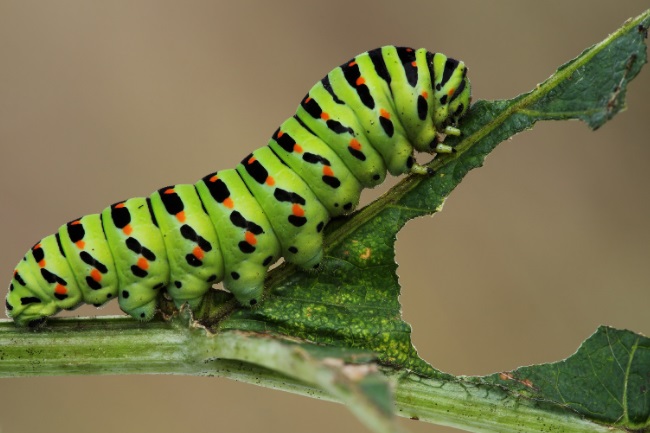
In North America, there’s one caterpillar that’s so famous for munching on gardener’s prized parsley that it’s been nicknamed the ‘parsley worm’. The black swallowtail is a beautiful butterfly; it’s large dark wings fringed with rows of yellow dots that are more prominent in the male. Like most swallowtail butterflies, it has a pointed tip to the bottom of the wing. While gardeners might be happy to have their graceful adult sipping nectar from thistles and milkweed, they’re somewhat less happy about its ravenous young.
The black swallowtail caterpillar is how we often picture caterpillars, a chubby green sausage stripped with black and speckled in yellow dots. It’s rather adorable so long as it isn’t eating its way through your veg bed. This caterpillar may be well known for eating parsley, but they have a reasonably wide-ranging diet, enjoying many species from the carrot family, such as dill, water cowbane and Queen Anne’s lace.
Something that all of its food has in common is being high in toxins. However, this brave little caterpillar doesn’t let that put him (or her) off, using the toxins for its defence by accumulating them in its body. It’s this that makes them less appealing to predatory birds.
Also read: What do Caterpillars Eat? (Vegan vs. Carnivore Caterpillars)
Beet armyworm
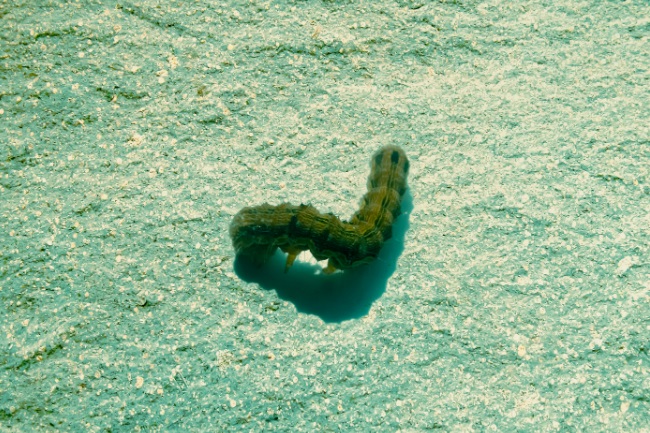
Even the name conjures up an invasion of these little caterpillars, and for most of the world, that’s precisely what it’s been. The beet armyworm was originally native to Asia, but in the 19th century was spread to North America and has since been found in almost every continent in the world. It may not look like much, this small brown caterpillar turning into the small brown small mottled willow moth, but it’s a huge agricultural pest.
Eating almost anything from lettuce to peas to asparagus, it’s well hated by the farming community. Not only does it consume the crops, it often destroys them in such a way that there is no chance of salvaging them. It particularly likes buds or shoots and will often eat away at the growing part of the plant, or burrow into the heart of lettuces, so that it’s not just a case of removing a few nibbled leaves.
Control of such as tiny insect is difficult. However, one saving grace is that is doesn’t survive cold temperatures, so it will die off in the winter in cooler regions, though it will re-establish itself in the summer when the world warms up again.
Also read: Is a Caterpillar an Insect? (Explained)
Black cutworms
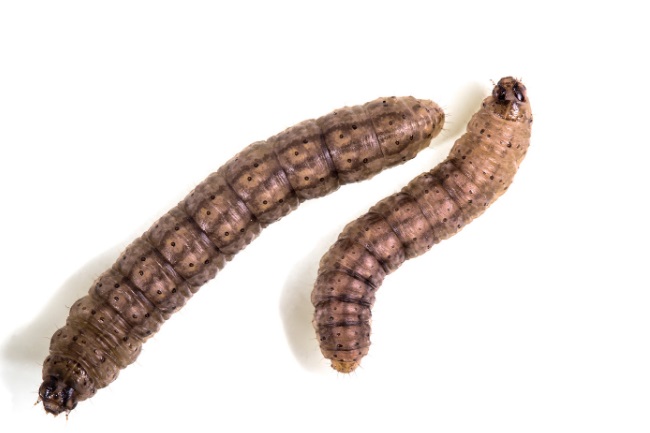
Cutworms are perhaps best known for the immense damage they can do to corn crops. What makes them so devastating is their tendance to eat young shoots and leaves, the older larvae cutting them off at the base and sometimes dragging them underground. Sometimes parsley is planted as a companion crop. It can attract predators to the cutworm when it flowers; however, some cutworm species are also more than happy to munch away at the parsley leaves when given a chance.
A small dark caterpillar, the black cutworm is sometimes called the greasy cutworm for its skin’s greasy appearance. It can easily be confused with other cutworm species, though up close, it can be differentiated. Like many insects, these tiny moths hitch a ride on the jet stream to migrate up and down the country to keep pace with the warm weather.
Also read: Does a Caterpillar Have Legs? (Prolegs vs. True Legs)
Silver Y Moth
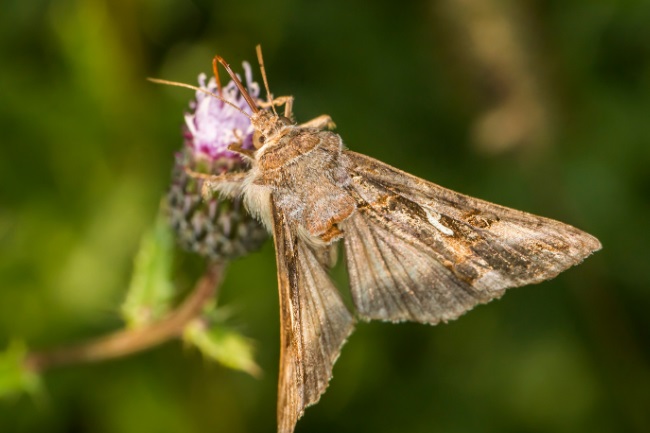
The Silver Y moth is easy to identify as an adult; it’s dull brown wings decorated with a handsome silver Y. When resting in the vegetation, it looks remarkably like a leaf or twig, various bumps in its form encouraging this disguise. It is found throughout Europe, into North Africa and across Russia, though it often migrates into the colder regions from the south, as it cannot survive harsh winters.
As a caterpillar, it is rather plain-looking, a little green creature munching its way through various plants, including a number of herbs such as basil and parsley. They have been known to cause significant crop damage, which has made them an unwelcome pest on agricultural land.
Also read: How to Deal with Whiteflies on Plants? (Prevent Damage)
Angle-shades moth
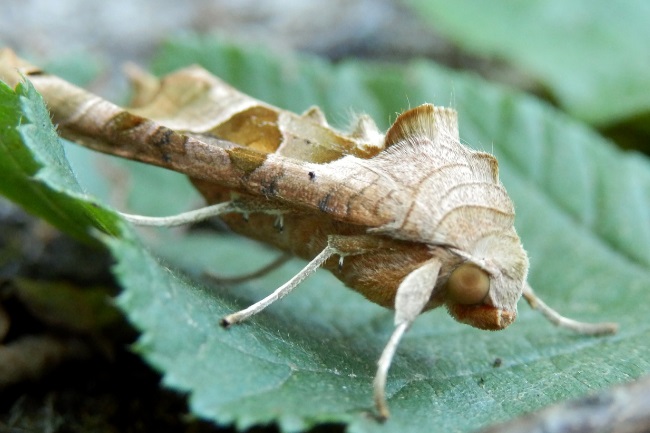
The angle-shades moth proves that not all moth species are dull and uninteresting. This stunning moth has an elongated shape, the edges of its wings pulled down into points. Its patterning resembles camouflage paint with shades of green, brown and pink marked out across its wings. Though it might seem hard to miss when held against a contrasting background, its colours and patterns are ideal for camouflaging it against dried leaves or wood.
This species is found throughout Europe and is strongly migratory. Its larvae are somewhat less exciting with the adult, coming in a pale green and a brown form. They aren’t particularly fussy in their eating habits, happy to feed on a range of plants from birch trees to brambles.
Also read: Moths Reproduction Explained (Larvae, Eggs,…)
The battle continues
When we talk about evolution, we often do so as if it were in the past. Yet, the arms race between hungry insects and their unwilling hosts continues. Though we may not enjoy losing our crops or having our favourite flowers destroyed, there may be hidden benefits to this ongoing battle. Perhaps one day, the toxins that plants are developing to rid themselves of their caterpillars will be those that safe us from horrible illnesses and diseases. Or maybe

